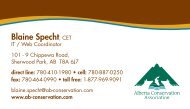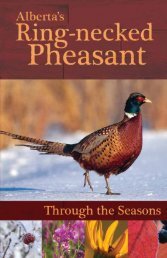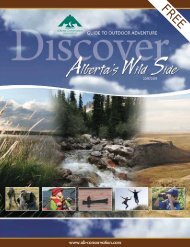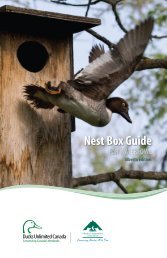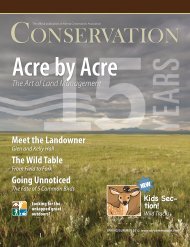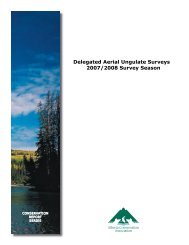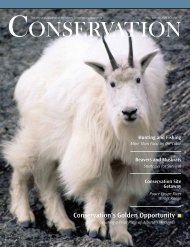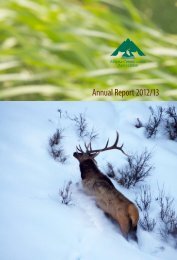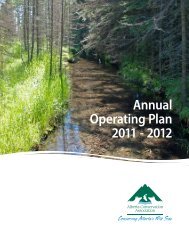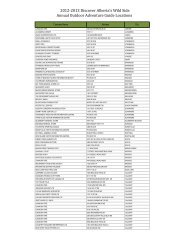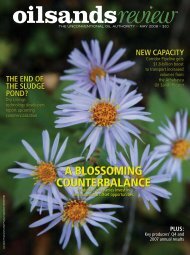Water-loving Weasels - Alberta Conservation Association
Water-loving Weasels - Alberta Conservation Association
Water-loving Weasels - Alberta Conservation Association
Create successful ePaper yourself
Turn your PDF publications into a flip-book with our unique Google optimized e-Paper software.
for producers, other landowners and their<br />
communities. Since its inception, the society<br />
has conducted riparian health assessments<br />
throughout <strong>Alberta</strong>, each based on a<br />
comprehensive set of environmental and<br />
landuse variables (www.cowsandfish.org). Many<br />
of these health assessments are carried out with<br />
<strong>Alberta</strong> <strong>Conservation</strong> <strong>Association</strong> (ACA).<br />
Partnership projects:<br />
Bearberry Creek and<br />
Moose Lake<br />
ACA has participated in many watershedscale<br />
projects across the province. Bearberry<br />
Creek flows west of Sundre, <strong>Alberta</strong>, and is a<br />
tributary to the Red Deer River. Once a popular<br />
destination for anglers, sport fish populations<br />
have declined drastically along with<br />
changes in habitat within the drainage.<br />
Riparian and aquatic habitat<br />
degradation along Bearberry Creek<br />
has resulted from land-use practices,<br />
including intensive livestock grazing<br />
and the construction of a weir in<br />
Sundre. Streambanks that were once<br />
densely covered by willows are now<br />
sparsely vegetated, dominated by<br />
tame grasses or completely bare.<br />
Fish populations consisted mainly of<br />
non-game fish species throughout the<br />
drainage.<br />
The Bearberry Creek <strong>Conservation</strong> Working<br />
Group was formed as a result of several<br />
agencies coming together with the same vision:<br />
to develop a conservation project that will<br />
improve watershed health and to assist with<br />
the re-establishment of a recreational fishery<br />
in Bearberry Creek. Together the group and<br />
ACA established three riparian protection and<br />
enhancement demonstration sites. They include<br />
a riparian pasture, a solar powered off-channel<br />
watering system and a bank stabilization project<br />
using bioengineering treatments<br />
(www.ab-conservation.com).<br />
Another project at Moose Lake, <strong>Alberta</strong>, is using a<br />
unique technique called aerial videography. ACA,<br />
ASRD and Cows and Fish performed a riparian<br />
health assessment along the entire shoreline of<br />
Moose Lake. This helped to identify priority areas<br />
in their <strong>Water</strong>shed Management Plan. These<br />
assessments have also been completed around<br />
Lac La Biche, portions of the Red Deer River, lvan<br />
Lake, Bonnie Lake, Pigeon Lake, Lake Wabamun<br />
and countless other streams and water bodies<br />
within the province. This is a very economical<br />
and effective way for watershed stewardship<br />
groups and other conservation organizations to<br />
get a picture of the overall health of <strong>Alberta</strong>’s<br />
riparian areas.<br />
A healthy shoreline along Moose Lake, MD of Bonnyville.<br />
Establishing guidelines for<br />
riparian areas<br />
Defining a riparian area of sufficient width<br />
adjacent to a water body to effectively protect<br />
the water and the aquatic ecosystem has been<br />
the subject of much debate. A one-size-fitsall<br />
approach has traditionally been used by<br />
provincial regulators and is still being used<br />
today; however, it is becoming increasingly<br />
apparent that water bodies require a unique<br />
set of guidelines to define appropriate riparian<br />
buffer widths and development setbacks.<br />
Recently, Aquality Environmental Consulting<br />
Ltd. in Edmonton (www.aquality.ca) developed<br />
the Riparian Setback Matrix Model. This<br />
scientifically-based and legally defensible model<br />
can be used by municipalities to determine<br />
appropriate riparian buffer widths to maintain<br />
healthy aquatic resources. The model is based<br />
on easily measured physical variables found<br />
along shorelines, such as vegetative cover<br />
and composition, bank height, slope and<br />
groundwater influence.<br />
The model has been officially adopted by Lac La<br />
Biche County and the MD of Rocky View. Rocky<br />
View is also developing riparian and wetland<br />
policies to protect shorelines within<br />
its municipality. This powerful tool<br />
can be adapted for use in any area<br />
of the province, around any water<br />
body, and has the ability to calculate<br />
buffer widths for everything from<br />
the prevention of pollution, to the<br />
protection of wildlife corridors and<br />
habitat.<br />
It is essential that municipalities<br />
establish appropriate land uses<br />
adjacent to bodies of water, including<br />
wetlands, to avoid or minimize<br />
development impacts of valuable<br />
water resources, as provided in the<br />
provincial Land Use Policies. The<br />
importance of establishing and protecting<br />
a properly-sized riparian area is extremely<br />
important for sustaining nature’s greatest<br />
resource.<br />
Aquality<br />
ACA provides funding to qualified landowners<br />
for riparian restoration. Please visit <strong>Alberta</strong><br />
<strong>Conservation</strong> <strong>Association</strong>’s website at www.abconservation.com<br />
or call toll free 1-877-969-9091<br />
to find out how you qualify. n<br />
How do you minimize<br />
your impact on the<br />
environment<br />
Ask Golder.<br />
We see solutions where others don’t. Because so much depends on sustainable and practical<br />
solutions, your needs for effective environmental services are growing. With over 45 years of experience,<br />
Golder Associates Ltd. can provide innovative thinking and cost effective solutions, including:<br />
• <strong>Water</strong> Resource Planning<br />
• Aquatic and Terrestrial Baseline Studies<br />
• Permitting Support<br />
• Environmental Impact Assessments<br />
• Land and <strong>Water</strong> Reclamation<br />
• Implementation of Mitigation / Compensation Plans<br />
A World of Capabilities Delivered Locally.<br />
© 2009, GAC<br />
Edmonton 780 483 3499<br />
Calgary 403 299 5600<br />
Fort McMurray 780 743 4040<br />
solutions@golder.com<br />
www.golder.com<br />
14<br />
<strong>Conservation</strong> Magazine • Spring/summer 2009




